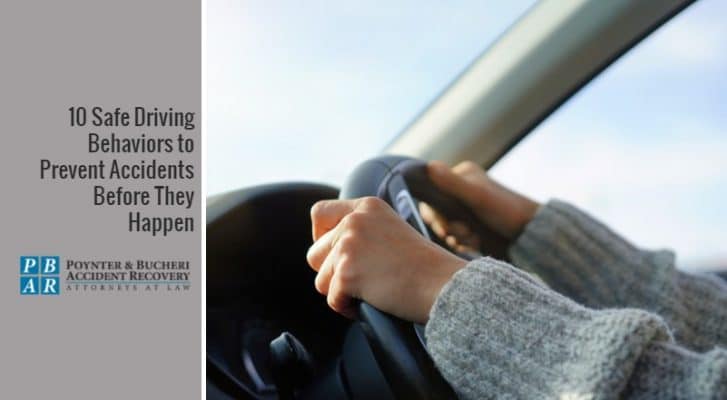
10 Safe Driving Behaviors to Prevent Accidents Before They Happen

What you’ll learn reading this article:
- The best way to stay safe while driving is to anticipate accidents that are waiting to happen.
- Defensive driving strategies help you avoid an accident on the road.
- Learn 10 safe driving behaviors you can use every time you’re behind the wheel.
They say the best way to stay safe while driving is to anticipate accidents that are waiting to happen. Every time you’re driving a vehicle on Indiana roads and highways, you should practice safe driving strategies, if you hope to prevent or avoid an accident. Here are 10 of them.
#1 Defensive Driving
As a defensive driver, you remain alert at all times because you assume other drivers will make errors. You watch ahead for advance warning of any hazards on the road, so you have enough time to avoid potential accidents. You also learn to anticipate hazards by scanning every 10 to 12 seconds in front of traffic and all around your car, adjusting speed or direction to react safely to any road condition or any vehicle that suddenly swerves into your path.
#2 Right of Way
In general, the vehicle that arrives last must give right-of-way to other vehicles. Drivers should give right-of-way when entering traffic, when turning left in front of approaching traffic and when changing lanes. Only move in your intended direction after assuring you will not conflict with other traffic. When pulling into traffic, proceed slowly, look and listen. Be aware of any blind spots, such as those in rearview mirrors and behind windshield pillars or highway road signs. Vehicles can seemingly appear out of nowhere so caution is the key to yielding the right-of-way.
#3 Start-up and Back-up
Starting your car and moving forward, backward, to the right or left creates a potentially hazardous situation for pedestrians and other vehicles. Before starting the car, walk around it and look underneath to make sure you have the right clearance. After checking around your car, start up quickly and move slowly at first to allow any vehicles or pedestrians who may have unexpectedly approached to safely move away.
#4 Negotiating Curves
When negotiating curves at an excessive speed, cars can lose traction and slide off the road. Commercial trailers and other top-heavy vehicles risk rolling over. Reduce speed before entering a curve. You want to have enough time to correct direction and maintain control of the vehicle. Keep side wheels off the shoulder of the road. Side wheels may drop or sink in the shoulder, increasing the chances of an accident.
#5 Passing
Safe passing maneuvers require well-developed skills. The steps to pass another vehicle successfully include checking sight distance ahead and mirrors for rear traffic and traffic passing you; estimating speed and position of approaching vehicles and the time needed to safely pass; accelerating, steering and checking for traffic entering on side roads.
#6 Crossing Intersections
We know a majority of car accidents occur in intersections. Vehicles coming from different directions into an overlapping space creates a reason for safe driving habits to kick in and anticipate a hazardous situation. Count to three before entering an intersection on a green light. Look both ways to make sure other vehicles are not trying to race through a yellow light.
#7 Using and Changing Lanes
Lane use and lane changing accidents usually involve sideswiping and rear-end collisions. These are usually the result of following too closely or being inattentive of the traffic conditions ahead. Observing a safe following distance and stay aware of blind spots -especially with large commercial trailers. If you cannot see ahead of the vehicle you are following, increase your following distance.
#8 Parking
In metropolitan areas as well as rural routes, you should try not to park in travel lanes, even partially. If you need to park on the shoulder of the road, always put on flashers, day or night, to avoid accidents.
#9 Driving in Adverse Conditions
The two biggest factors causing accidents in adverse conditions are reduced traction and reduced visibility. Reduced traction conditions include rain, snow, ice, slush and gravel on roads. Reduced visibility conditions include twilight, darkness, rain, snow and fog. You should develop skills in compensating with speed and control of your vehicle. In addition, you should be prepared to compensate for other drivers who may not have the skills to deal with adverse conditions.
#10 Pedestrian Interaction
Many pedestrian accidents occur when a person walks into a roadway and misjudge how fast a vehicle is traveling. They either don’t see a vehicle coming or they assume the vehicle sees them and will slow down or stop. You should be constantly aware of the potential errors a pedestrian might make and compensate accordingly.
Poynter & Bucheri Accident Recovery – Indianapolis Personal Injury Attorneys
If you or a loved one has been injured physically or mentally by a person, product or company, you need to know your legal rights. Our personal injury attorneys are experienced with cases like yours and can evaluate what your case may be worth. We will ensure that you are protected and compensated for your injuries and losses. Why pay up to 40% in attorney fees? Our fee is only 25%* and we fight to win your case or you pay no attorney fees at all. Don’t hesitate – one of our experienced attorneys can assist you right away. Call 1-800-265-9881 for a free case review.
